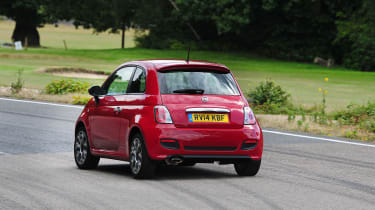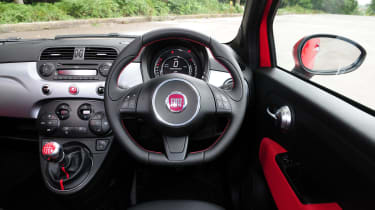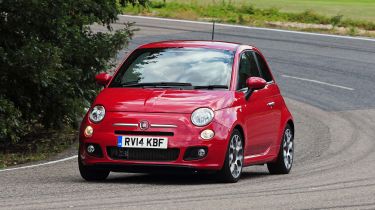Fiat 500 TwinAir review
Fiat 500 TwinAir gets a power hike and cabin upgrade. We deliver our verdict

The Fiat 500 TwinAir is still gorgeous and bursting with character, but an unfortunate cocktail of ergonomic flaws and equipment gaps adds up to make the 500 rather less desirable than it should be. The awkward driving position and numb steering mean it’s not quite the hoot to chuck around that you’d hope – so on that basis, we don’t think you need to shell out extra for this faster, thirstier TwinAir.
In updating the Fiat 500, the brand hasn’t subjected its city car to the kind of overhaul that its MINI arch rival recently had, and that’s due to more than simply a desire to save cash.
The 500 is as fresh-faced today as the reborn icon was in 2007. Fiat has mixed some new colours for its cute body, and new alloy wheels for it to roll around on, too. Visually, the 500 is wearing well but, now we’ve driven it in the UK for the first time, how does the facelifted car compare to the new MINI?
More power and fewer emissions are always in vogue, which is why the 500 gets a revised TwinAir engine line-up. The diminutive 875cc two-cylinder turbo is now available with 104bhp, as tested here, which costs £600 more than the old car’s 84bhp version. (You can still buy that engine in the new range, too.)
Used - available now

2022 Mercedes
GLC
35,715 milesAutomaticDiesel2.0L
Cash £30,587
2021 Mazda
CX-5
14,540 milesManualPetrol2.0L
Cash £19,887
2023 Land Rover
Range Rover Evoque
20,056 milesManualDiesel2.0L
Cash £21,787
2022 Kia
e-Niro
54,760 milesAutomaticElectric
Cash £15,287Weirdly, you’ll have to press the dash-mounted Sport button to get 104bhp, though, otherwise you’ll be in 97bhp ‘eco’ mode. That’s a slightly odd name for the less powerful state of tune, since Fiat claims economy and CO2 emissions for both modes are identical. We say leave it in Sport – the car will remember your selection and always start up in that mode, and it makes no difference to the steering or the suspension.

Switching between the modes will, however, refresh the graphics on the 500’s most noticeable change: an all-new, digitised instrument display. This will be familiar to anyone who’s driven the Kia Cee’d, as its layout is very similar.
A large digital speed readout dominates the centre of the screen, around which are date, time and outside temperature. This is flanked on the left by a stack rev counter, which curiously displays an 8,000rpm red line despite the TwinAir spinning to only 6,000rpm. On the right, normal mode shows a staggered Eco gauge – drive flat-out and a red blob sits around the bottom of the scale. Behave yourself and it rises like a spirit-level bubble to become a green halo at the top of the display, next to the fuel gauge.
In Sport mode, this is replaced by a fun turbo boost gauge (just like the Kia Pro_cee’d GT’s), while all fonts switch into a racy-looking typeface similar to Ferrari’s instruments. That attention to detail, along with the chequered-flag graphics, metal gearlever and sculpted leather wheel, hint that this bottom rung of the Fiat Group is channelling some of the magic of more exotic relatives.

Performance? Well, the TwinAir is faster, if not super-fast: 0-62mph takes one second less than in the 84bhp 500, and the irrelevant top speed climbs 10mph to 117mph. Getting close is a struggle, though. The 500’s gearbox has never been the slickest shifter, and with the laggy TwinAir dawdling from rest then charging into the red line hard enough to suspend passengers in their seatbelts, brisk progress can be tiresome.
It also destroys economy. Forget 67.3mpg (5.1mpg inferior to the slower model); no TwinAir gets close to its claimed figures. Our test average was 38.7mpg, and zipping about town sends that tumbling. Easing off the throttle stops you falling out of the uncomfortable and unsupportive high-set seats, which along with poorly spaced pedals and a non-reach-adjustable wheel give an absurd driving position.
Over the years, as we get used to the 500’s charms, these flaws become harder to forgive. Much better to relax and enjoy the commendably tight turning circle – along with the alterations Fiat’s made to the car’s suspension since the early models, which mean it no longer tackles speed bumps like a space hopper.







